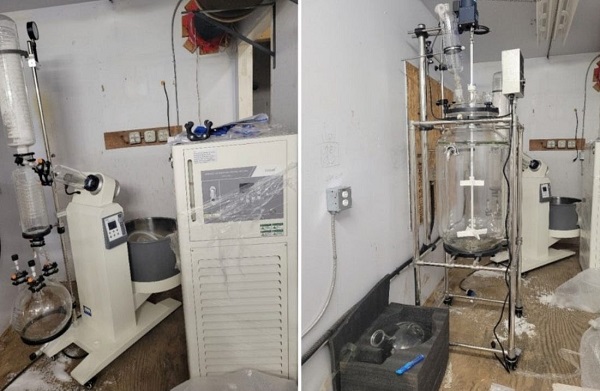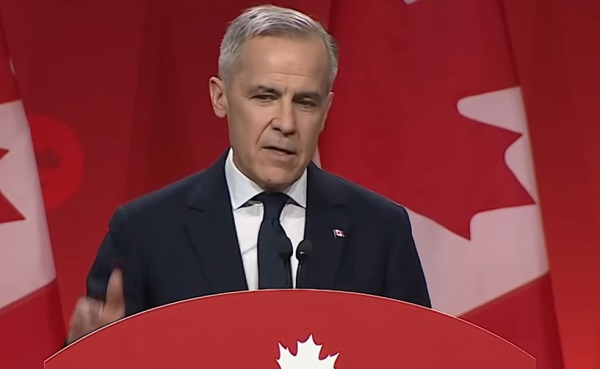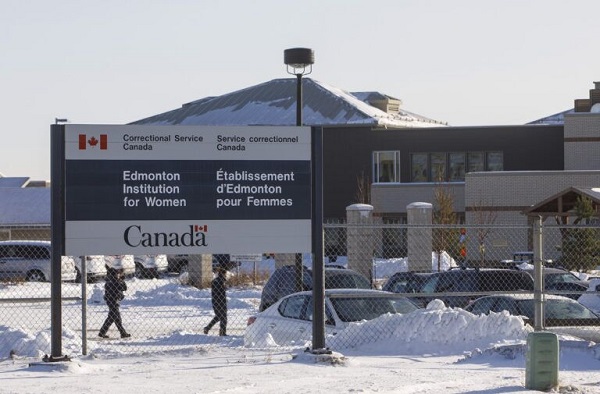Crime
Red Deer RCMP recent arrests include seizures of fentanyl and carfentanil

February 9, 2018
Red Deer, Alberta – Recent arrests by Red Deer RCMP have involved seizures of fentanyl and carfentanil, property crimes and fraud, and the continued focus on prolific offenders who fail to comply with court-imposed conditions. Many arrests have been thanks to targeted patrols in areas that show high levels of criminal activity, as part of Red Deer’s Pinpoint crime reduction strategy. Pinpoint uses an intelligence-driven policing model to identify problem areas, prolific offenders and emerging issues, and Red Deer RCMP target their enforcement accordingly.
February 5 – 2018157742
At 1:15 am on February 5, RCMP on patrol in downtown Red Deer located a woman who was wanted on outstanding warrants. During her arrest, RCMP seized crystal meth.
44 year old Tamara Dawn Johnson faces the following charges:
· CDSA 4(1) – Possession of Schedule I substance X 2
· Criminal Code 145(3) – Fail to comply with conditions
Johnson is scheduled to appear in court in Red Deer on February 13 at 8:30 am.
January 31 – 2018139725
At 10:15 pm on January 31, RCMP on patrol in downtown Red Deer located a female suspect who was wanted on a number of outstanding warrants from four separate files. During her arrest, police seized methamphetamine and carfentanil.
In addition to her warrants, 34 year old Tomasina Ballentyne faces the following charges:
· CDSA 4(1) – Possession of Schedule I substance X 2
· Criminal Code 145(3) – Fail to comply with conditions X 2
Ballentyne was remanded to appear in court on February 2; she is scheduled to appear again on February 12 at 9:30 am.
January 31 – 2018135103
Shortly before 2 am on January 31, RCMP on patrol in a high crime area located a suspicious vehicle; as they approached, the male driver fled on foot but was arrested after a brief foot chase. RCMP seized a baggie of fentanyl and approximately $1,700 as proceeds of crime.
40 year old Ryan Michael Simoneau faces a charge of possession for the purpose of trafficking (CDSA 5(1)); he is scheduled to appear in court in Red Deer on February 20 at 8:30 am.
January 31/ 30 – 2018138969/ 2018134164/ 20171260250
Shortly before 6 pm on January 31, RCMP responded to a report of a theft suspect being pursued by retail security staff after the theft of a backpack from a fitness facility. The suspect fled on foot and was seen getting on a Red Deer Transit bus. RCMP located the bus, executed a traffic stop, and removed the suspect. There was no impact on riders or interruption of transit service as a result of the arrest.
The suspect had been arrested the day before by Red Deer RCMP at a north end restaurant after police responded to a report of a disturbance and determined that the suspect was wanted on outstanding warrants after failing to appear in court on charges related to the theft of client items from a different fitness facility in September.
30 year old William James Webb faces the following charges for both incidents:
· Criminal Code 334(b) – Theft under $5,000 X 2
· Criminal Code 355(b) – Possession of stolen property under $5,000
· Criminal Code 145(5) – Fail to comply with conditions
· Criminal Code 145(2)(a) – Fail to attend court
Webb was scheduled to appear in court in Red Deer on February 8 on one charge and on March 23 at 9:30 am for the others. He did not attend court today and the possession of stolen property charge has now gone to warrant status.
January 30 – 20171520442
Red Deer RCMP located and arrested 32 year old Jessie Singh Dodd, who was wanted on warrants after failing to appear in court regarding a November file in which he resisted arrest and was found to be in possession of weapons in violation of his probation. He appeared in court in Red Deer on February 2 and is scheduled to appear again on February 23 at 9:30 am.
January 29 – 2018126031
RCMP on patrol in a high crime area shortly after 1 am on January 29 located a stolen vehicle occupied by a male suspect. RCMP moved into position to surround the vehicle in case of an attempted flight from police, and initiated a traffic stop. The suspect was taken into custody without incident and police seized methamphetamine from him; at the time of his arrest, he was found to be breaching several court-imposed conditions.
51 year old Gordon Edouard Cameron faces the following charges:
· Criminal Code 355(a) – Possession of stolen property over $5,000
· Criminal Code 145(5.1) – Fail to comply with conditions X 2
· CDSA 4(1) – Possession of Schedule I substance
Cameron was remanded to appear in court in Red Deer on January 31; his next court appearance is scheduled for February 28 at 9:30 am.
January 25 – 2018108796/ 20171675122
In the early hours of January 25, Red Deer RCMP located two men in a vehicle in a high crime area who were wanted on numerous outstanding warrants; one was found to be breaching several court-imposed conditions at the time of his arrest, including a curfew condition and conditions not to be in a vehicle if he was not the registered owner.
42 year old Kirk Kuske was wanted on six warrants out of Ponoka for possession of stolen property (X 2), evade police, theft, obstruction, and operating a motor vehicle while disqualified. He now faces additional charges of:
· Criminal Code 145(3) – Fail to comply with conditions X 2
· Criminal Code 259(4) – Operate motor vehicle while disqualified
Kuske was remanded to appear in court in Red Deer on January 26; he is scheduled to appear again on February 13 at 9:30 am.
49 year old Craig Oliver was wanted on eight warrants out of Red Deer for fraud under $5,000 000 (CC 380(1)(b)) after Red Deer RCMP identified him as a suspect in repeated frauds committed at a local grocery store, where he is alleged to have used stolen credit cards to purchase hundreds of dollars worth of product over multiple visits. RCMP identified him after obtaining surveillance images and issued arrest warrants for eight separate incidents of fraud between September and December of 2017.
Craig Oliver made his first court appearance in Red Deer on February 6 and is scheduled to appear again on February 26 at 8:30 am.
January 24 – 201885973
On January 24, Red Deer RCMP located a man who was wanted on a warrant after RCMP conducting curfew checks on January 20 determined that he was violating his court-imposed curfew. Red Deer RCMP conduct curfew checks on identified individuals as part of Pinpoint, the Red Deer RCMP crime reduction strategy that targets prolific offenders, crime hot spots and problem residences.
28 year old Brandon William Wallner faces a charge of failing to comply with conditions and was remanded to appear in court in Red Deer on January 30; his next court appearance is scheduled for February 13 at 8:30 am.
January 24 – 2018106290
At 1:30 pm on January 24, RCMP responded to a report of shoplifters in a downtown store. RCMP attended and retrieved surveillance images of the male and female suspects, then located them nearby in the downtown. The female suspect was in possession of the stolen items at the time of her arrest.
23 year old Lateesha Flodell was wanted on three outstanding warrants out of Lacombe at the time of her arrest; she was charged with an additional charge of theft under $5,000 and was scheduled to appear in court in Red Deer on February 2. Flodell did not appear in court and those charges have now gone to warrant status.
Business
Canadian Police Raid Sophisticated Vancouver Fentanyl Labs, But Insist Millions of Pills Not Destined for U.S.

 Sam Cooper
Sam Cooper
Mounties say labs outfitted with high-grade chemistry equipment and a trained chemist reveal transnational crime groups are advancing in technical sophistication and drug production capacity
Amid a growing trade war between Washington and Beijing, Canada—targeted alongside Mexico and China for special tariffs related to Chinese fentanyl supply chains—has dismantled a sophisticated network of fentanyl labs across British Columbia and arrested an academic lab chemist, the RCMP said Thursday.
At a press conference in Vancouver, senior investigators stood behind seized lab equipment and fentanyl supplies, telling reporters the operation had prevented millions of potentially lethal pills from reaching the streets.
“This interdiction has prevented several million potentially lethal doses of fentanyl from being produced and distributed across Canada,” said Cpl. Arash Seyed. But the presence of commercial-grade laboratory equipment at each of the sites—paired with the arrest of a suspect believed to have formal training in chemistry—signals an evolution in the capabilities of organized crime networks, with “progressively enhanced scientific and technical expertise among transnational organized crime groups involved in the production and distribution of illicit drugs,” Seyed added.
This investigation is ongoing, while the seized drugs, precursor chemicals, and other evidence continue to be processed, police said.
Recent Canadian data confirms the country has become an exporter of fentanyl, and experts identify British Columbia as the epicenter of clandestine labs supplied by Chinese precursors and linked to Mexican cartel distributors upstream.
In a statement that appears politically responsive to the evolving Trump trade threats, Assistant Commissioner David Teboul said, “There continues to be no evidence, in this case and others, that these labs are producing fentanyl for exportation into the United States.”
In late March, during coordinated raids across the suburban municipalities of Pitt Meadows, Mission, Aldergrove, Langley, and Richmond, investigators took down three clandestine fentanyl production sites.
The labs were described by the RCMP as “equipped with specialized chemical processing equipment often found in academic and professional research facilities.” Photos released by authorities show stainless steel reaction vessels, industrial filters, and what appear to be commercial-scale tablet presses and drying trays—pointing to mass production capabilities.
The takedown comes as Canada finds itself in the crosshairs of intensifying geopolitical tension.
Fentanyl remains the leading cause of drug-related deaths in Canada, with toxic supply chains increasingly linked to hybrid transnational networks involving Chinese chemical brokers and domestic Canadian producers.
RCMP said the sprawling B.C. lab probe was launched in the summer of 2023, with teams initiating an investigation into the importation of unregulated chemicals and commercial laboratory equipment that could be used for synthesizing illicit drugs including fentanyl, MDMA, and GHB.
The Bureau is a reader-supported publication.
To receive new posts and support my work, consider becoming a free or paid subscriber.
Invite your friends and earn rewards
Catherine Herridge
FBI imposed Hunter Biden laptop ‘gag order’ after employee accidentally confirmed authenticity: report

From LifeSiteNews
Two independent journalists found that the FBI could have set the record straight by confirming the laptop was real and the subject of an ongoing criminal probe. Instead, FBI leadership allowed the false narrative about the laptop to gain momentum.
In a shocking report published on X, independent journalists Catherine Herridge and Michael Shellenberger revealed that an FBI agent accidentally confirmed to Twitter (now known as “X”) that the Hunter Biden laptop story was real less than three weeks before the 2020 election.
“For the first time, and with a change of administration, the FBI has now turned over to GOP House investigators the internal chat messages that show Bureau leadership actively silenced its employees,” Herridge and Shellenberger wrote on X.
“The FBI, which had a special task force to counter foreign election interference, could have set the record straight by confirming the laptop was real and the subject of an ongoing criminal probe,” the journalists explained. “Instead, FBI leadership allowed the false narrative about the laptop to gain momentum.”
“In 2024, an FBI official admitted to House investigators that an FBI employee had inadvertently confirmed the authenticity of Hunter Biden’s laptop to Twitter on a conference call the morning of October 14, 2020, the day the New York Post published a story about it,” Shellenberger wrote.
“I recall that when the question came up, an intelligence analyst assigned to the Criminal Investigative Division said something to the effect of, ‘Yes, the laptop is real,’” testified the then-Russia Unit Chief of the FBI’s Foreign Influence Task Force in a closed-door transcribed interview,” according to Herridge and Shellenberger. “I believe it was an (Office of General Counsel) attorney assigned to the (Foreign Influence Task Force) stepped in and said, ‘We will not comment further on this topic.’”
They recounted this exchange:
An individual whose name is blacked out, tells Elvis M. Chan, the San Francisco-based FBI special agent tasked with interacting with social media companies, there was a “gag order” on discussion of Hunter Biden’s laptop. In a separate exchange, Chan is told “official response no commen(t).”
In the chat, the FBI officials showed awareness that the laptop may have contained evidence of criminal activity.
Asked Chan, “actually what kind of case is the laptop thing? corruption? campaign financing?”
Another FBI employee responds, “CLOSE HOLD —” after which the response is redacted.
To which Chan responds, “oh crap,” appearing to underscore the serious nature of the probe, which included felony tax charges. Chan adds, “ok. It ends here.”
In the same conversation, Chan is asked if “anyone discussing that NYPost article on the Biden’s?” Chan responds, “yes we are. c d confirmed an active investigation. No further comment.” “C D” is likely shorthand for the FBI’s Criminal Division.
Said another FBI employee, whose name was redacted by the Bureau, “please do not discuss biden matter.”
It’s now common knowledge that national security agencies — including the FBI and CIA, Big Tech, and much of corporate media — colluded in suppressing truth and manufacturing lies in order to drag their preferred candidate, Joe Biden, across the finish line in the 2020 presidential election.
Incriminating evidence discovered on the laptop that Hunter Biden had long ago abandoned at a computer repair shop — reported on in two devastating pieces by the New York Post at the time — was ignored by mainstream media, fraudulently dismissed by former national intelligence officials, and essentially made inaccessible to the public by Big Tech social media sites Twitter and Facebook.
The computer contained emails showing that then-Vice President Biden had come under the influence of bad actors in Ukraine and Communist China and had used his powerful position in the Obama administration to pressure government Ukrainian officials into firing a prosecutor who was investigating the energy firm, Burisma, which was paying the younger Biden $50,000 per month to sit on its board of directors.
-

 Also Interesting2 days ago
Also Interesting2 days agoMortgage Mayhem: How Rising Interest Rates Are Squeezing Alberta Homeowners
-

 2025 Federal Election2 days ago
2025 Federal Election2 days agoConservative Party urges investigation into Carney plan to spend $1 billion on heat pumps
-

 Also Interesting2 days ago
Also Interesting2 days agoExploring Wildrobin Technological Advancements in Live Dealer Games
-

 2025 Federal Election2 days ago
2025 Federal Election2 days agoCommunist China helped boost Mark Carney’s image on social media, election watchdog reports
-

 2025 Federal Election2 days ago
2025 Federal Election2 days agoFifty Shades of Mark Carney
-

 2025 Federal Election2 days ago
2025 Federal Election2 days agoCorporate Media Isn’t Reporting on Foreign Interference—It’s Covering for It
-

 Justice2 days ago
Justice2 days agoCanadian government sued for forcing women to share spaces with ‘transgender’ male prisoners
-

 Business1 day ago
Business1 day agoStocks soar after Trump suspends tariffs




